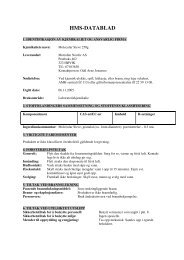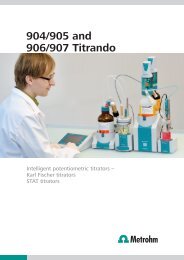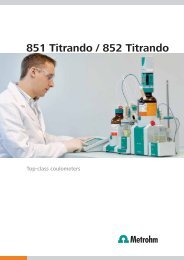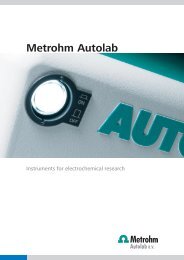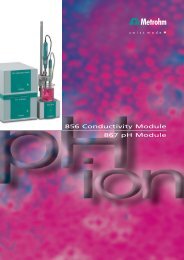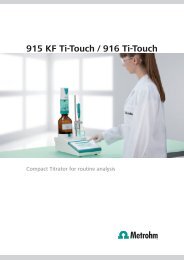General Catalog
General Catalog
General Catalog
You also want an ePaper? Increase the reach of your titles
YUMPU automatically turns print PDFs into web optimized ePapers that Google loves.
Instruments for polarography, voltammetry and CVS<br />
Introduction<br />
Metal traces: total metal and species analysis<br />
– quick and easy with voltammetry<br />
The voltammetry instruments from Metrohm have a<br />
low price, low running costs and compact dimensions<br />
but are great in detecting.<br />
Traces of toxic heavy metals can be analyzed at<br />
extremely low concentrations without much trouble.<br />
The detection limits are all in the ppt range, so that the<br />
necessary sensitivity can always be achieved. For ion<br />
speciation in analytes voltammetry is the method of<br />
choice.<br />
Trace metal analyses can be carried out with the same<br />
or better sensitivity for a fraction of the cost of acquiring<br />
an AAS or ICP instrument. The low running costs<br />
are an additional bonus point for voltammetry. Apart<br />
from small amounts of reagents only small volumes of<br />
pure nitrogen are required. No expensive combustible<br />
gases, no reconstruction of the laboratory for special<br />
gas supplies and fume hoods, no expensive lamps. And<br />
no time-consuming calibration of the analytical system.<br />
Convincing applications<br />
Analysis of metal traces<br />
Total concentration can be determined by both voltammetry<br />
and spectroscopic methods. With voltammetry,<br />
however, it is possible to distinguish between the different<br />
oxidation states of metal ions and to specify the<br />
biological availability of heavy metals. Free and bound<br />
metal ions can be differentiated from each other. This<br />
makes voltammetry an essential tool for environmental<br />
analysis. Spectroscopy allows comparable statements<br />
to be made only after complicated seperation of metal<br />
species. Due to the compact size the instrument can<br />
also be used in mobile laboratories.<br />
Samples with a high ionic concentration are not a<br />
problem for voltammetry. Voltammetry is also predestined<br />
for the analysis of:<br />
• water, wastewater and sea water<br />
• foodstuffs<br />
• salts, pure chemicals<br />
• electroplating baths<br />
Specific analysis of organic chemicals<br />
Not only metals but also various organic compounds<br />
can be determined by voltammetry. The technique<br />
is used in organic chemistry, e.g. for the analysis of<br />
contaminants, and in the pharmaceutical industry for<br />
the determination of the concentration of the active<br />
substance.<br />
Examples of interesting determinations<br />
• 4-carboxybenzaldehyde in terephthalic acid<br />
• free styrene in polystyrene<br />
• vitamins in fruit and vegetable juices, vitamin<br />
formulations<br />
Determination of anions<br />
Some special anions can also be determined by voltammetry.<br />
The analysis of the following environmentally<br />
relevant anions is particularly interesting:<br />
Sb III / Sb V<br />
As III / As V<br />
Bi<br />
Cd<br />
Cr III / Cr VI<br />
Co<br />
Cu<br />
Fe II / Fe III<br />
Pb<br />
Hg<br />
Mo IV / Mo VI<br />
Ni<br />
Pt<br />
Rh<br />
Se IV / Se VI<br />
Tl<br />
W<br />
U<br />
Zn<br />
1 ppt = part per trillion = 1 ng/kg<br />
00 ppt<br />
100 ppt<br />
500 ppt<br />
50 ppt<br />
5 ppt<br />
50 ppt<br />
50 ppt<br />
50 ppt<br />
50 ppt<br />
100 ppt<br />
50 ppt<br />
50 ppt<br />
0.1 ppt<br />
0.1 ppt<br />
300 ppt<br />
50 ppt<br />
00 ppt<br />
5 ppt<br />
50 ppt<br />
• cyanide<br />
• sulfide<br />
• nitrite<br />
• nitrate<br />
Typical detection limits in voltammetric trace analysis<br />
— VA




